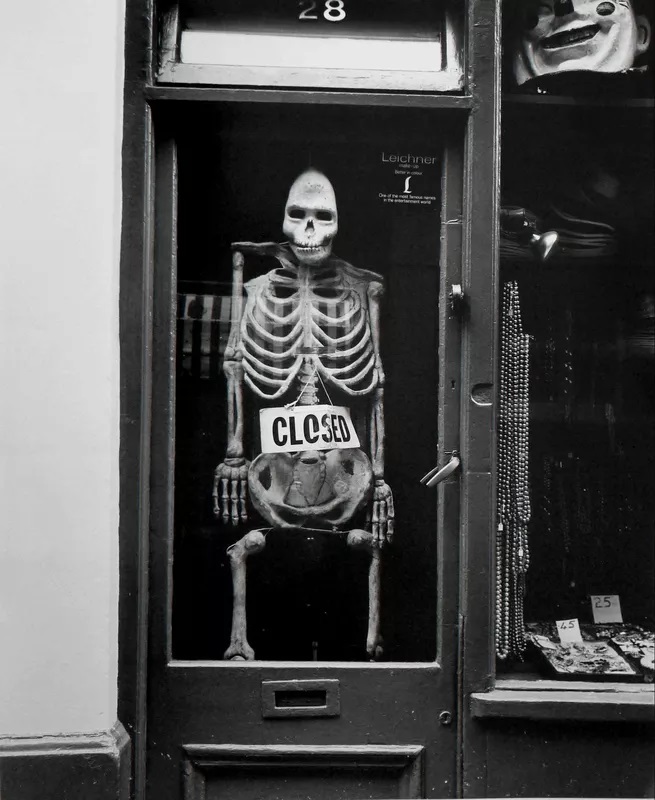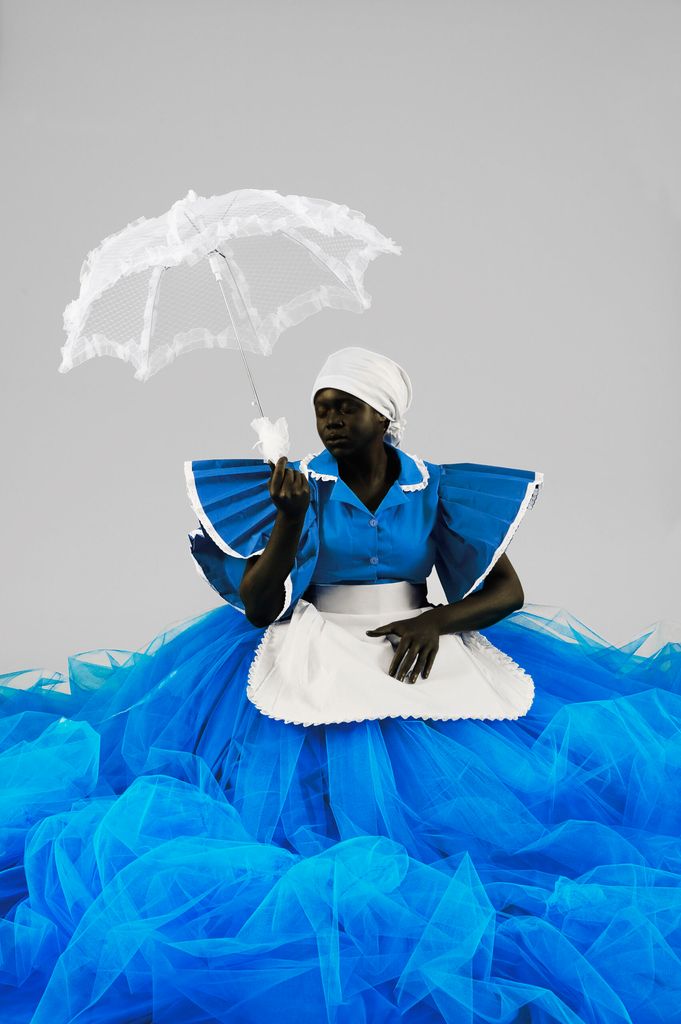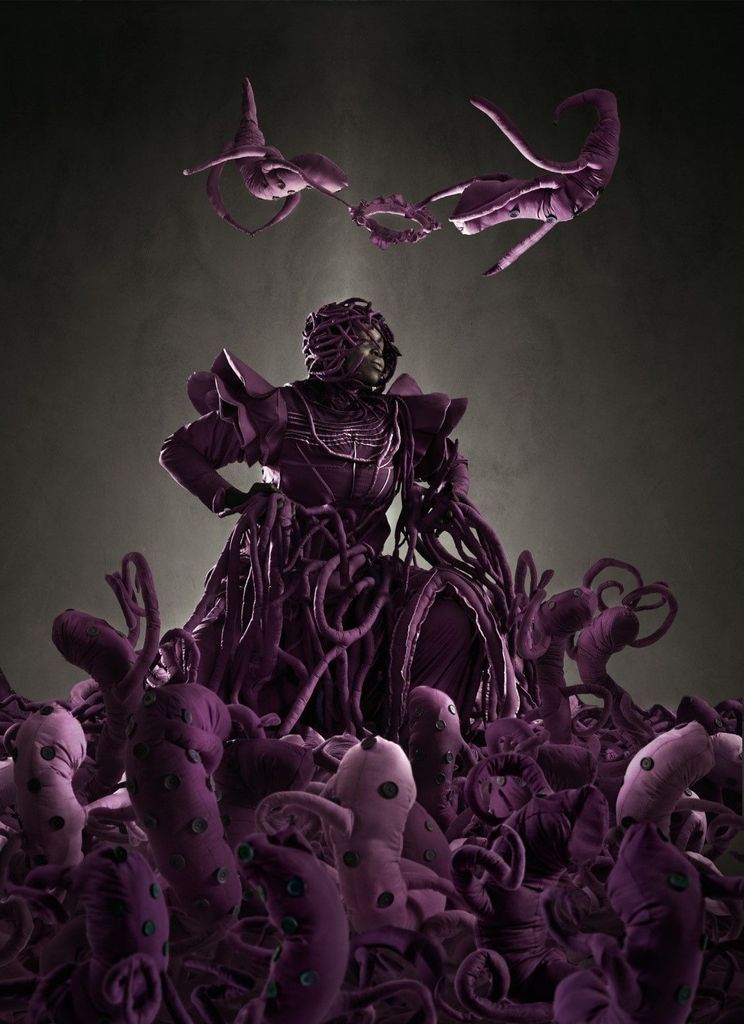Fabricated Faces: Obscured Self-Portraiture in the Works of Jo Spence and Mary Sibande
by Michaela Peine

Jo Spence (1934–1992) explored the potential for activating this liminal space between self and “other” through her self-reflective photographic work. Collaborating with Rosy Martin, Spence explored “phototherapy,” a therapeutic project in which Spence used photography sessions to emotionally embody different figures from her history, transforming into family members, younger versions of herself, or even repressed aspects of her personality.2 Although they are overt representations of herself—literal self-portraits—these photographs highlight Spence’s understanding of the mutability of this medium. She creates obscured self-portraits, images that hide or replace the artist, which seem to subvert the purpose and expectation of directly representational self-portraits. Spence’s obscured self-portraits reveal the deeper complexity of her inner life; she assumes a multitude of identities even as she offers her external image to the viewer.
Over the course of her work, Jo Spence studied what it means to capture a self-portrait that is not only an image of oneself, but also reveals insight into the multiplicity of one’s identity. Spence pushes even further in The Final Project (1991–1992), a final series of photographs spanning the last two years of her life following a decade-long battle with breast cancer and subsequent diagnosis of leukemia. Spence’s work in this period focuses on forcing the viewer away from the objectification of her—as a woman, as a one-dimensional human, or as a passive patient suffering from illness—towards subjectification, wherein the viewer accepts the diversity of her complex individuality. Through the photographs of The Final Project Spence creates “hidden” self-portraits where she intentionally objectifies and conceals herself, replacing her own body or face with symbolic objects and images. As the viewer searches for Spence in the photographs, they are forced into a more profound space where they must also confront her intellectual multiplicity and transcendental existence.

In The Final Project [Various 7] (1991), a single photograph from her project, Spence once again models her own body, turning the camera on her personal experience (fig. 1). Aware of her terminal diagnosis and quickly approaching the end of her physical self, Spence forces her viewer to face this difficult reality. Spence’s self-portrait in [Various 7] is fully obscured; she has replaced her literal face and body with a plastic skeleton.3 In case the skeleton is not immediately obvious as a self-portrait, Spence reinforces this connection by mimicking the composition, location, and coloring of an earlier self-portrait, Remodeling Photo History: Colonization (1981–82) (fig. 2). Both photographs highlight the central figure through shocking white (either the white of Spence’s bare skin or the bones of the stripped skeleton) and surround it with decontextualized material trappings (i.e., the shadowy goods of a store interior, or the domestic broom, beads, and milk jars surrounding Spence). However, it is the stance of the two figures that links them most strongly as self-portraits. In [Various 7], Spence confronts the transformation of herself into a portrait, as evidenced by the skeleton dominating the frame of the image, staring directly at the viewer with the same inscrutable gaze. Meanwhile, in Colonization, Spence hides her gaze behind round dark glasses; she stares directly at us through the black sockets of her skeleton. In both images, Spence occupies a door frame, a liminal space. But while the door of Colonization offers her a portal to step closer to the viewer, the door in [Various 7] has undergone the same transcendental transformation Spence will transverse through death. Essayist Anne Boyer writes that “to look at a skeleton—a human-like form that has shed the imposed visual markers of race, gender, and class—is to see the erasure of social inscription, to look on a post-identity democracy of the dead.”4 We see Spence’s skeleton in the door, but we are separated from it by a pane of glass and a “closed” sign. We may look upon her, but she is no longer accessible to us. Instead, we are left to contend with her spiritual identity; viewing her photographs after her death, we must confront the ways she does or does not live on.
Also challenging our perceptions of her identity, Mary Sibande (1982–present) performs a parallel sleight-of-hand with her self-portrait. Born in apartheid-era South Africa, Sibande combines fashion design, sculpture, and photography to similarly confront the questions of created and modified identity. Stepping into the question of the hidden self-portrait, Sibande created “Sophie,” an alter ego sculpture based on a cast of her own body and adorned with flowing, elaborate gowns. While Sophie is a literal copy of herself, Sibande conceals the self-portrait; she assigns it a brand-new identity, “Sophie,” requiring her viewer to grapple with this externalized and disguised selfhood. Although Sibande creates this distance between herself and her self-portrait, she uses the objectification of herself in Sophie to explore her own complex relationship to her history. Scholar Tracey L. Walters describes this approach to self-portraiture, writing, “as both artist and subject, Sibande uses her body to reincarnate her relatives and give them license to claim their own identities.”5 Sibande utilizes her self-portrait not only to resurrect, but also to explore her own identity within the context of her family history.

The daughter of three generations of domestic workers, Sibande first dressed Sophie in blue-and-white, colors synonymous with the profession; however, Sophie encapsulates many seemingly contradictory identities (fig. 3). While she wears the colors of a domestic worker, the designs of the gowns are elaborately lavish, mimicking the clothing of the rich women who would hire domestic workers. At times both uniforms and custom high-fashion gowns, the changing array of Sophie’s costumes requires viewers to be constantly assessing and reassessing Sophie’s place in society.6 Looking back to the racism and oppression of apartheid as well as the strength and resilience of her foremothers, Sibande uses her self-portrait—obscured through the interface of Sophie—to encapsulate the contradictory identities of her history. Sophie is a self-portrait and an “other,” the image of a victim and an aggressor, an individual and a nation.

In The Admiration of the Purple Figure (2013), Sibande expands the scope of her mediated self-portraits (fig. 4). Sophie emerges in the photograph wearing bright purple, rather than the Dutch-favored blue of domestic workers. This color bears deep personal, social, and political significance; in the South African Purple Rain protest of 1989, anti-apartheid protesters were sprayed by authorities with purple dye to mark the revolutionaries for arrest. In Admiration of the Purple Figure, Sibande draws sharp attention to this change of color, specifically baptizing Sophie in purple, a personal and political transformation. Although Sophie’s eyes remain closed—gone are the demure poses of her blue iteration—Sophie rises powerfully above a twisting sea of purple forms that seem to worship her yet also be a part of her, connected as if by umbilical cords. No longer does Sophie wear the hoop skirts and puffed sleeves of the apartheid elite, but instead dons a kind of battle-armor and helmet, and the fabrics of her skirt have themselves taken life, becoming the aggressive purple structures blanketing the ground. These same structures stretch to place a circlet on her head, crowning her. Through Admiration we see many forms of rebirth taking place through the specificity of Mary Sibande’s selfhood. Sibande objectifies herself, transforming her body into the character of Sophie; however, this disguised self-portrait provides a liminal space where Sibande forces the viewer to confront the complex identities of her own history.
Through their obscured self-portraits, Jo Spence and Mary Sibande interrogate perceptions of themselves. Spence fully replaces her body, forcing the viewer beyond the physicality of her image to confront her individual spirit that lives past her death. In many ways, Sibande’s self-portraits perform the opposite maneuver; through the objectification of her body, Sibande resurrects the multifaceted histories of those who have gone before her and shaped her. Spence and Sibande challenge our understanding of the self-portrait, pushing the limits of its definition and function. Viewing Spence and Sibande’s self-portraits requires the viewer to meet them in a place of mutual vulnerability, forcing the acknowledgment of their complex identities.
____________________
Michaela Peine received her BA in English and Studio Art from Hillsdale College, specializing in oil painting and portraiture. She is pursuing an MA at the University of St. Thomas studying Art History with a certificate in Museum Studies. She is currently researching contemporary artistic responses to Northern Renaissance and Baroque art, as well as decolonial educational practices in museums.
____________________
Footnotes
1. Amelia Jones provides the baseline for my theories of portraiture and self-staging. Most especially in her discussion on the exaggerated performative qualities of self-portrait photography, Jones lays a groundwork highlighting the self as a tool to be manipulated or transformed. Amelia Jones, “The ‘Eternal Return’: Self-Portrait Photography as a Technology of Embodiment,” Signs 27, no. 4 (Summer 2002): 947–978.
2. Rosy Martin and Jo Spence, “New Portraits for the Old: The Use of Cameras in Therapy,” Feminist Review 19 (Spring 1985): 66–92.
3. Anne Boyer identifies the skeleton motif throughout all of The Final Project as a mutable self-portrait, a commentary on Spence’s imminent death as well as a form of self-immortalization. Anne Boyer, “The Kind of Pictures She Would Have Taken,” Afterall: A Journal of Art, Context, and Enquiry 42 (Autumn/Winter 2016): 4–11.
4. Boyer, “The Kind of Pictures She Would Have Taken,” 6.
5. Tracey L. Walters, “The Art of Dressing Up in Mary Sibande’s Long Live the Dead Queen,” in Not Your Mother’s Mammy (New Brunswick: Rutgers University Press, 2021), 127.
6. For a more detailed breakdown of Sibande’s designs for Sophie, read Tracey L. Walters’ chapter.